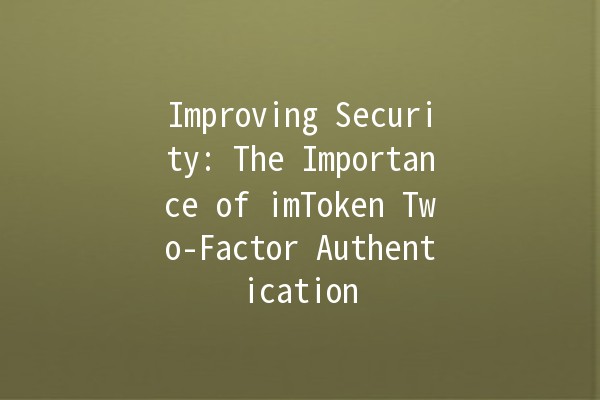In today's digital world, securing your cryptocurrency assets is paramount, and the imToken wallet provides an excellent platform for managing your digital assets safely. One essential feature that strengthens the security of imToken is the twofactor authentication (2FA). This article delves into the nuances of imToken twofactor authentication, offering practical advice and productivityboosting techniques to enhance your security practices.
TwoFactor Authentication (2FA) adds an additional layer of security to your account beyond just your password. When 2FA is enabled, you will be required to provide not only your password but also a second piece of information, usually a temporary code sent to your mobile device or generated by an authentication app.
This dual verification significantly reduces the risk of unauthorized access, as even if someone mistakenly obtains your password, they would also need access to your second verification method to gain entry into your account.
With this understanding, let's explore five productivityboosting tips that you can implement to effectively use imToken's 2FA feature.

When setting up 2FA, you often have multiple options. Common choices include SMS codes, email codes, and authenticator apps.
Using an authenticator app like Google Authenticator or Authy is generally considered more secure than receiving codes via SMS. These apps generate timesensitive codes that are not susceptible to simswapping attacks, providing greater peace of mind.
Keeping your authentication app uptodate ensures that you benefit from the latest security features and patches.
Set a reminder to check for updates on your authenticator app weekly. This simple task can prevent potential vulnerabilities, ensuring your 2FA remains robust against new threats.
When setting up 2FA, many apps provide backup codes that can be used if you lose access to your authenticator app.
Store these backup codes securely in a password manager or a physical location that is not easily accessible to others. This ensures you won’t be locked out of your account in case something goes wrong with your primary authentication method.
While 2FA adds an additional layer of security, it is crucial to have a strong and unique password as your first line of defense.
Utilize a password manager to create and store complex passwords for each of your accounts. Combining a strong password with 2FA creates a formidable barrier against unauthorized access.
Regularly reviewing your account activity helps to detect any unauthorized access attempts promptly.
Make it a routine to check your imToken transaction history and security settings monthly. Identifying unusual activities early can help prevent potential threats, allowing you to act quickly.
To enable 2FA on your imToken wallet, navigate to the settings section, find the security options, and select “Enable TwoFactor Authentication.” Then, choose your preferred verification method and follow the onscreen instructions to set it up.
If you lose your phone, immediately use your backup codes to log back into your imToken account. You should also reset your 2FA settings by contacting imToken support to deactivate the old 2FA method.
Yes, you can disable 2FA through the security settings in your imToken wallet. However, keep in mind that disabling it may expose your account to security threats.
SMSbased 2FA sends a code to your mobile number, while appbased 2FA generates a code on your device. Appbased is considered more secure because it is less vulnerable to interception and phishing attacks.
No, your account is not secure if you combine 2FA with a weak password. Always use a strong, unique password alongside 2FA for optimal security.
If you forget your password, follow the account recovery process provided by imToken. Ensure that your recovery email or phone number is uptodate, as this information will be crucial in regaining access to your account.
By integrating these 2FA techniques into your daily security practices, you can significantly bolster the protection of your imToken wallet and cryptocurrency assets. Implementing a reliable twofactor authentication system not only protects your funds but also gives you peace of mind, knowing that your digital financial life is secure.